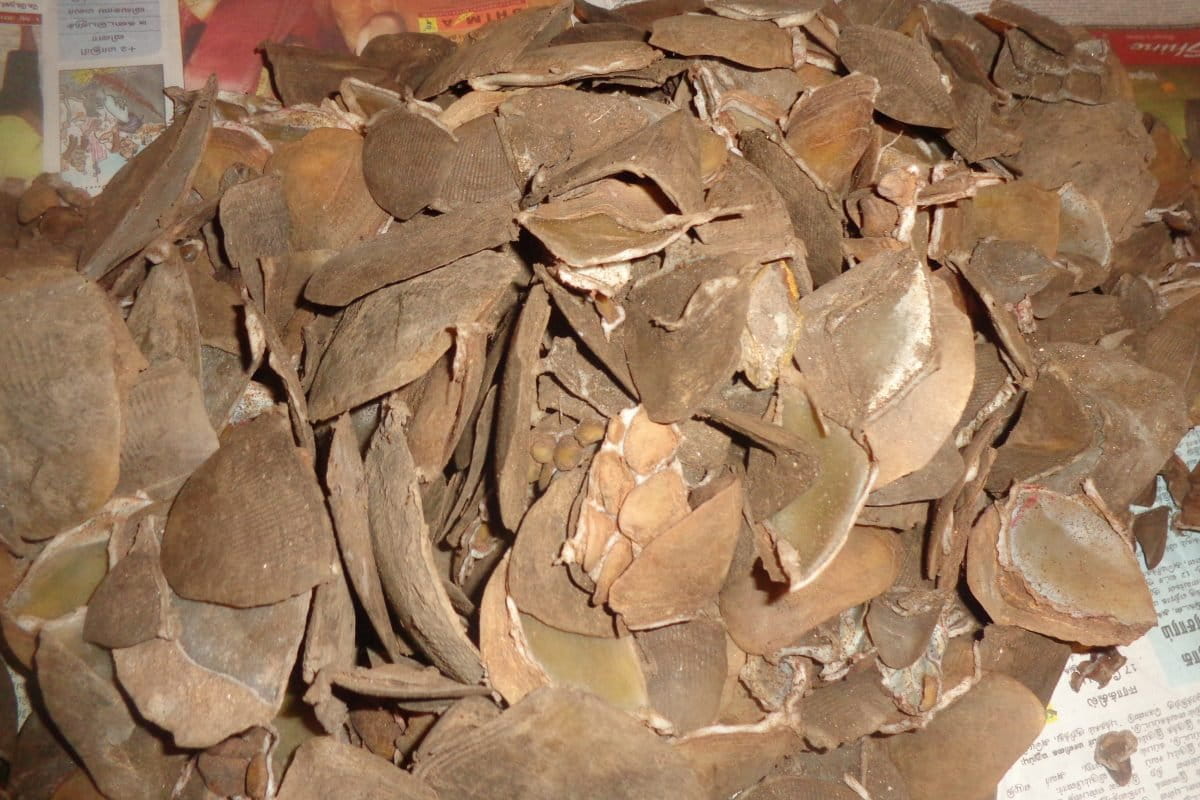- The pangolin is the world’s most trafficked mammal and protected under Schedule I of India’s Wildlife Protection Act, 1972. Recently, all eight species of pangolins were moved to the Appendix I of CITES.
- In the northern part of the Eastern Ghats, pangolins are hunted with various motives like local market demand, traditional hunting practices, conflict with wildlife and even for partial subsistence.
- In this commentary, researchers from the Ashoka Trust for Research in Ecology and the Environment (ATREE), recount their experience while studying this species in the Eastern Ghats and the threats facing it.
The day was cloudy, mist covered our faces for the most part. The early morning rain had caused the birds to go into temporary hiding, but they were quick to show up after the sun came out. The sun made it quite humid but the views of the gently rolling hills of the Eastern Ghats forests covered in mist, with sunlight beaming through the clouds made our work a little less stressful.
The forests of the northern Eastern Ghats hill region of Andhra Pradesh are drained by a network of streams that meander across the landscape to finally meet the mighty Godavari river. We were trekking our way through the forest crossing one such stream several times as it refused to let go of the forest. It was not long until we stumbled upon something interesting, or rather, troubling. We found quills of the Indian porcupine lying on the forest floor.The number of quills were few, around 10 to 15 if we were getting it right but it was enough to create some suspicion. As we walked ahead we found more quills on the trail, with the number of quills increasing each time.
We finally reached the spot where the animal was killed. The place had some blood stains and a pile of porcupine quills. This nocturnal rodent is quite commonly hunted in this region for its meat. It is not strange in these forests to find more people than wildlife. And more often than not, they are carrying a bow and arrow, hoping to find something. Most of them are disappointed with their unsuccessful hunts, and they say that wildlife populations have gone down significantly over the years.
In another part of the forest, on a different day, we had an interesting conversation: “Rs.15,000 to Rs. 20,000 for a kg of scales,” said the person holding a bow and arrow. The next obvious question we asked was, “What do you do with the meat?” “We eat it,” he said. We were surprised by his comfortable demeanour. Why? Because we had assumed that it would not be common to come across a local and talk about the world’s most trafficked mammal – the pangolin.

The species is protected under Schedule I of India’s Wildlife Protection Act, 1972. Recently, all eight species of pangolins were moved to the Appendix I of CITES (Convention on International Trade in Endangered Species of Wild Fauna and Flora), which bans the international commercial trade of all pangolin species. Although this move could be considered a small win for pangolins from the trade point of view, the situation on ground seems much worse. Nearly 6,000 pangolins were involved in illegal trade from 2009-2017 as per the latest TRAFFIC-India report. Manipur, Tamil Nadu, Assam, Karnataka and Odisha were the top five states with the highest number of seizures. Andhra Pradesh only accounts for about one percent (1 to 2 seizures) of all the seizures in India as per the report.
However, given the prevalence of local hunting in the northern Eastern Ghats, we would like to interpret those figures with caution. There are no population estimates for the Indian pangolin, which leaves us in a rather helpless situation as there is no way to quantify the impact of hunting on this species. This alarming but unique setting provided us with the opportunity to study the impacts of hunting and trade on the endangered Indian pangolin in the forests of northern Eastern Ghats of Andhra Pradesh.
The threatened pangolin
The Indian pangolin is a highly elusive nocturnal mammal that occurs at low densities in a range of habitats across India, Sri Lanka, Bangladesh and Pakistan including several moist and dry forest tracts, dry scrub and grasslands where they inhabit burrows in the ground. Pangolins are evolutionarily distinct, having separated from their nearest relatives and are classified under their own order called Pholidota. Yet, they are obviously closely related to each other, being placed in one family Manidae and belonging to the mammalian order Pholidota. Pangolins are exclusive insectivores, feeding entirely on ants and termites which they draw out of mounds by probing their long sticky tongues. They play an important ecological function of controlling ant and termite populations in forests.
Being insectivores, their bodies have evolved and specialised over millions of years for this role. This is most obvious in the shape of their heads which are small and pointed, allowing them to easily burrow and enter anthills and termite mounds. Their bodies are also covered with a characteristic scaly armour consisting of 10-13 rows of small to large-sized scales covering their dorsal (back) side to protect them from ant bites. These scales also make them impenetrable to most predators and lends them the name, scaly anteater. Unfortunately, these very scales have become their Achilles’ heel, for they are prized by people who hunt the pangolin for its scales.
On the other hand, pangolins are completely vulnerable on the ventral (chest and stomach) side. For this reason, they adopt a characteristic defensive posture of curling up into a tight ball when attacked by predators to protect their defenceless side. However, this method of defence, although effective against predators such as leopards and tigers, has proved to be useless against humans who then simply pick the curled up pangolins and kill them by dumping them into boiling water. Pangolin numbers are crashing not only because of the heavy hunting driven by the local and international demand for their scales, skin and meat but also because of their inherent biology. They are solitary animals which usually only give birth to one young each and also tend not to breed well in captivity. As a consequence of these factors, all eight pangolin species worldwide are currently threatened.
Indigenous hunting of pangolins and other forest fauna including mammals, birds and reptiles is customary throughout the northern Eastern Ghats hill region. The landscape shelters several indigenous tribal communities who practice age-old traditional hunting techniques. Hunting festivals are quite common among the various indigenous tribal groups. A common hunting festival, locally known as ‘bhumipanduga’, is celebrated and practiced extensively. During this festival, men go in a group of 20-30 individuals to carry out a hunt from dawn to dusk. The group is split into two, one cluster herds the animals, while the other ambushes them from the opposite direction. There are various motives for localised hunting, the most common ones being the local market demand for them, traditional hunting practices, conflict with wildlife and even for partial subsistence.
Most hunting in this region is not market driven. However, a few species like gaurs and langurs, which are not consumed by a tribe, like the Konda Reddis, are ocassionally hunted and then traded for money. The pangolin is another such species which is hunted mostly for the existing market value of its scales.
Money for scales
“We call it ‘Jadum’ in our language,” said a Koya tribal. “We don’t find it these days,” he whispered, after being shown the picture of an Indian pangolin.
Nearly every individual interviewed during the study could instantly and correctly identify the pangolin and about half of them replied that they have hunted it either in the past or in more recent times. Even though sighting pangolin is rare, opportunistic hunting of the species still prevails. The methods for hunting pangolins are different from techniques used for other animals in this region.

Apart from using traditional methods like bows and arrows, the modus operandi primarily involves tracking the animal to its burrow with the help of dogs, setting fire to the burrow, waiting near the burrow and hitting the animal on its head with the intent to kill. According to locals, pangolin occurrence has come down enormously since the past few years, mostly due to hunting. Pangolins were hunted in the past too, but unlike now, previously the scales were just burnt or discarded. The use of pangolin scales in this region is fairly different from their use in the international market.
Locally, a pangolin scale is shaped into a ring or a pendant and used for delusory purposes like prevention of black magic, for detecting poisoned food and are also believed to cure kidney stones and piles. Traders come for small towns and buy them from the tribals. But where is the pangolin being traded to? The locals have no clue about this, all they know is that pangolins and their scales fetch money.
Rohit Subhedar, Krishna Pavan and Vikram Aditya are researchers with the Ashoka Trust for Research in Ecology and the Environment (ATREE) and part of an ongoing study to map the distribution of the pangolin in the northern Eastern Ghats and assess threats to it.
Banner image: Pangolin scales. Photo from the Wildlife Crime Control Bureau.
Read more: Is India becoming a centre for pangolin poaching?
